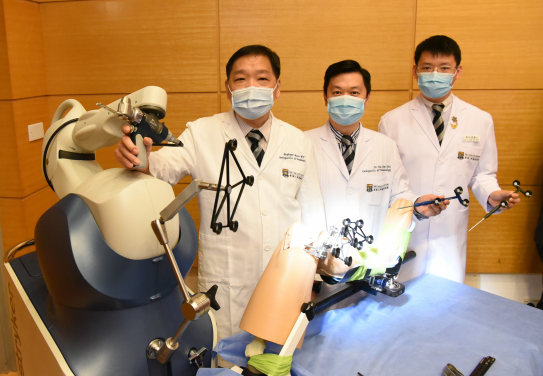Media
HKUMed introduces the latest robotic arm assisted joint replacement technology for enhancing surgical precision
28 May 2020
With advances in robotic arm joint replacement technology, the Department of Orthopaedics and Traumatology, LKS Faculty of Medicine of the University of Hong Kong (HKUMed) is the first in Hong Kong to utilize the technology for joint replacement surgery in public hospital setting.
End-stage hip and knee arthritis are functionally debilitating disorders. Hip and knee replacement can effectively improve the quality of life of these patients. However, the clinical outcomes and survivorship from joint replacement surgery depend heavily on surgical technique and implant alignment.
Conventionally, joint replacement surgery is performed with manual instruments. Preoperative planning is done on two-dimensional images, bone removal is performed manually with cutting jigs and implant placement is done freehand. Implant alignment and soft tissue balance cannot be accurately quantified and rely heavily on the surgeon’s experience. Although navigation has emerged in the past 20 years, it can only offer intraoperative guidance to surgeons, while bone removal is still uncontrolled with the risk of error.
Robotic Arm Assisted Joint Replacement Surgery
Using the latest robotic arm technology for joint replacement surgery, surgical precision, safety and accuracy can be improved. Surgical planning is done on three-dimensional CT scans which enable accurate patient-specific planning. Bone removal is under haptic control by the robotic arm thus improving precision and reducing outliers. Implant placement in total hip replacement is also controlled by the robotic arm. Compared to other surgical systems, this latest robotic arm called “Mako” is the only system with FDA approval for total hip replacement, total knee replacement and partial knee replacement, which account for over 95% of joint replacement service.
Since the availability of the robotic arm system, international studies have shown robotic joint replacement surgery, when compared to conventional joint replacement, has higher accuracy and consistency of implant positioning, is safer with less soft tissue trauma, has less postoperative pain, earlier functional recover, shorter length of stay and lower revision rates. With consistent accurate implant placement, complications can be reduced, and implant survivorship is expected to improve in the long run.
Early Results
The Department of Orthopaedics and Traumatology, HKUMed was the first in Hong Kong to utilize robotic arm technology for joint replacement surgery in public hospital setting since January 11, 2019. As of May 22, 2020, the Division of Joint Replacement Surgery has completed 161 robotic surgeries, including 79 total knee replacements, 35 partial knee replacements and 47 total hip replacements. All patients achieved good rehabilitation progress without major complications. In particular, for total hip replacement, postoperative imaging showed 98% of achieving desired implant position, compared to the conventional of only 80%. For robotic total knee replacement, all patients showed early functional recovery with successful straight knee raise on day one, with 84% of patients being discharged directly. For partial knee replacement, the robotic technique produced more consistent component alignment. With the availability of robotic arm system, the Department aims to conduct clinical research and prove its efficacy for local patients.
Dr Yan Chun-hoi, Clinical Associate Professor and Chief of the Division of Joint Replacement Surgery, Department of Orthopaedics and Traumatology, HKUMed said, “Robotic technology provides superior joint line restitution in partial knee replacement with a short learning curve phenomenon. It can be an excellent teaching tool for young surgeons.” Dr Henry Fu Chun-him, Honorary Clinical Assistant Professor of the Department of Orthopaedics and Traumatology, HKUMed, who was in charge of the robotic joint replacement project commented, “Joint replacement surgery for patients with complex hip and knee deformities used to be a nightmare for both the surgeon and the patient, but with the aid of robotic technology, surgery is a lot safer and guaranteed.”
About the surgical team
The surgical team, from the Department of Orthopaedics and Traumatology, HKUMed, includes: Dr Yan Chun-hoi, Chief of the Division of Joint Replacement Surgery and Clinical Associate Professor; Dr Henry Fu Chun-him, Honorary Clinical Assistant Professor; and Professor Peter Chiu Kwong-yuen, Li Shu Fan Medical Foundation Professor in Orthopaedic Surgery and Clinical Professor. Majority of the robotic partial knee replacements, robotic total hip replacements and robotic total knee replacements were performed by Dr Yan, Dr Fu and Prof Chiu, respectively. All three of them are now certified trainers for robotic joint replacement surgery.
Acknowledgement
The Department of Orthopaedics and Traumatology, HKUMed would like to thank The Tam Shiu Charitable Trust for their generous donation to acquire the Mako robotic arm assisted surgical system.
Media Enquiries
Please contact LKS Faculty of Medicine of The University of Hong Kong by email ([email protected]).

